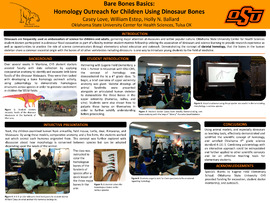| dc.identifier.citation | Love, C., Estep, W., & Ballard, H. N. (2020, Feb. 28). Bare bones basics: Homology outreach for children using dinosaur bones. Poster presented at Research Day at Oklahoma State University Center for Health Sciences, Tulsa, OK. | |
| dc.description.abstract | Dinosaurs are frequently used as ambassadors of science for children and adults, garnering major attention at museums and within popular culture. A new mentorship opportunity at Oklahoma State University Center for Health Sciences (OSU-CHS) utilizes the association of dinosaurs and science learning to provide research experience as well as education and outreach training opportunities for medical students. Cadaver-based Human Gross Anatomy is a foundational course in the first-year medical school curriculum, providing the framework on which more advanced system-focused courses are based. During the summer between the first- and second-year curriculum, two OSU-CHS College of Osteopathic Medicine (COM) students participated in a dinosaur fossil excavation in the badlands of Montana as part of an OSU-CHS faculty mentor-student mentee research fellowship. Students were tasked with making field identifications of excavated fossils by applying their human gross anatomy training, and in turn, this actively explored the concept of skeletal homology: that the bones in the human skeleton share a common ancestral origin with the bones of all other vertebrates, including dinosaurs (e.g., the human arm and T. rex arm are comprised of the same suite of bones). During the following fall semester, the COM students developed a bone homology outreach activity for children at Eugene Field Elementary, a Title 1 Partner in Education with OSU-CHS. Skeletal homology is frequently taught by visual aid worksheet comparisons of the bones in the arm of humans and animal exemplars such as bats, horses, and birds, with students color-coding the equivalent (homologous) bones in each animal limb. The COM students elaborated upon this activity, showing children the humerus first on a human skeleton and themselves, then subsequently passing around the humeri of a mouse, deer, turtle, and armadillo, and having the students illustrate the animal from which they thought it came from based on bone size, shape, and a few animal behavior clues. The children began to understand that similar to themselves, animals have a humerus. Finally, a two-foot-long dinosaur humerus excavated from the Montana site was passed around, and the children were thrilled to learn from the COM students that even dinosaurs had the same kind of bones in their arm as the kids have. The OSU-CHS faculty mentor-student mentee fellowship provided COM students an opportunity to 1) assist with faculty data collection in the form of fossil excavation by applying anatomical knowledge from the classroom concretely in a scientific capacity, subsequently honing critical thinking and deduction skills; and 2) translate their experiences and understanding of bone homology into an elementary school activity, thereby practicing the role of science communicators. Most importantly, the STEM activity developed by the COM students uses children's fascination and excitement toward dinosaurs to teach them about the medical profession, and the activity is appropriate for the Oklahoma fourth-grade science standard 4-LS1-1. | |
